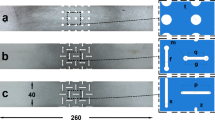Abstract
Dynamic photoelasticity employing a 16-spark gap Cranz-Schardin camera system was used to determine certain conditions leading to fracture arrest by a circular hole ahead of a propagating crack. Photoelastic models of 3/8×10×10-in. Homalite-100 plates with a 1/2-in. edge crack were loaded in a fixed-grip configuration and crack arrest was made possible by central holes of 1/2, 1/4, and 0.15-in. diameters. In one test of a uniformly loaded plate with a central hole of 0.15-in. diameter, the propagating crack continued through this hole. Changes in dynamic-stress-intensity factors, as the crack tip approaches the hole, as well as changes in the dynamic-stress-concentration factors at the far side of the hole were studied, and these results were compared with the corresponding static results determined by finite-element analysis. This comparison shows that the static analysis can be used to qualitatively assess the arrest capability of the hole using the maximum static-stress concept or the proposed concept of strain energy released as the crack penetrates the hole.
Similar content being viewed by others
References
Shah, R. C., and Tiffany, C. P., “Examples of the Use of Linear-Elastic Fracture Mechanics Technology to Solve Specific Aerospace Problems,” to be published in Proc. of Engineering Applications of Fracture Mechanics Technology, ASME 91st Winter Annual Meeting (November 1970).
Bluhm, J. I., “Fracture Arrest,” Fracture—An Advanced Treatise, H. Liebowitz (editor),5,1–63, Academic Press (1969).
Irwin, G. R., “Basic Concepts for Dynamic Fracture Testing,”J. of Basic Engineering, Trans., ASME,91 (3),Series D.,519–524 (Dec. 1969).
Kanninan, M. F., “An Augmented Double Cantilever Beam Model for Studying Crack Propagation and Arrest,” Battelle Memorial Inst. Rept. (Sept. 1970).
Bradley, W. B., andKobayashi, A. S., “An Investigation of Propagating Cracks by Dynamic Photoelasticity,”Experimental Mechanics,10 (3),106–113 (March 1970).
Chan, S. K., Tuba, I. S., andWilson, W. K., “On the Finite Element Method in Linear Fracture Mechanics,”J. of Engineering Fracture Mechanics,2 (1),1–18 (July 1970).
Watwood, V. B., Jr. “The Finite Element Method for Prediction of Crack Behavior,”Nuclear Engineering and Design,11,323–332 (1969).
Erdogan, F., “Crack-Propagation Theories,” Fracture—An Advanced Treatise, H. Liebowitz (editor),2,498–590 (1968).
Bradley, W. B. and Kobayashi, A. S., “Fracture Dynamics—A Photoelastic Investigation,” to be published in the Int. J. of Engineering Fracture Mechanics.
Author information
Authors and Affiliations
Rights and permissions
About this article
Cite this article
Kobayashi, A.S., Wade, B.G. & Maiden, D.E. Photoelastic investigation on the crack-arrest capability of a hole. Experimental Mechanics 12, 32–37 (1972). https://doi.org/10.1007/BF02320787
Received:
Accepted:
Issue Date:
DOI: https://doi.org/10.1007/BF02320787




